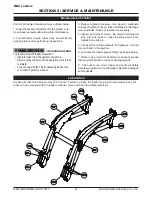
MAX Loaders
8
WESTENDORFMFG RR315270
Westendorf Manufacturing Co., Inc.
SECTION 2: SAFETY
BALLAST
refers to cast weights or fluid added to rear tractor tires. Hitch ballast refers to a weight or an implement attached to the tractor three-point hitch.
GROSS VEHICLE WEIGHT (GVW)
is the sum of front and rear axle weight caused by the mass of the tractor, loader, attachment, payload, ballast and hitch ballast.
The operational ballast criterion has been met when
a minimum of 25% of the gross vehicle weight is
retained on the rear axle in a static condition on
level ground.
•
A mass equivalent to the Lift Capacity maximum height
should be placed in the loader bucket, with the boom
raised until the bucket pivot pin is the same distance
from the ground as the boom pivot (farthest forward
position). The rear axle weight and gross vehicle weight
should be measured on hard level ground (+ 1
o
) under
these conditions. See Figure 1.
•
Ballast must be added to the rear wheels and/or hitch
until the rear axle weight on level ground is a minimum
of 25% of the gross vehicle weight. Ballast added to
the rear hitch should be kept as low as practical.
•
When a loader is used in a dedicated situation,
an operator may determine the appropriate ballast,
based on the maximum load to be carried.
•
We recommend ballast, based on the criteria listed
in above and knowledge of the physical character-
istics of the tractor.
This engineering practice is intended as a guide to determine the minimum ballast and tread settings recommended for the operation of a front loader
mounted on a 2WD tractor or a tractor with front assist. These ballast and tread setting recommendations are intended to reduce the risk of vehicle over-
turn during typical operation.
The rear wheel width is the most important specification to the balance of your tractor loader operation.
Always use approved ROPS and fasten your seat belt.
Minimum tread settings are recommended to provide static stability on a side slope up to 15 degrees under
proper rear ballast conditions listed in above. If minimum tread settings are not available in your mounting
instructions, minimum rear tread settings should be selected from the following chart:
Minimum Tread Settings
STEP 1:
Put weight in the bucket equiv-
alent to the lift capacity of the loader at
full lift height. The lift capacity
can be found in several locations:
• Operators manual
• Company Literature
• Visit us online at www.loaders.com
• Or Call Us at 712-423-2762
STEP 2:
At the scale get the gross
vehicle weight
(GVW)
with the loader
raised so the bucket pivot pin is as high
as the boom pivot pin.
See Figure 1
.
Then weigh the rear axle
(R)
.
STEP 3:
Formulas to figure ballast.
GVW x 25%
= Required Rear Axle
Weight
(RRAW)
< IS LESS THAN > IS GREATER THAN
If R
>
RRAW = No Ballast Required
If R
<
RRAW = Ballast Required
Figure Rear Ballast Required (RBR):
RRAW - R = RBR
RBR x 133% = Ballast Required
Note:
Since adding ballast increases the total
weight adding the difference will not be enough.
You need to add approximately 133% of the dif-
ference. Depending on where you add the ballast
in respect to the rear axle the amount of weight
may vary.
Determination of Ballast
Three Simple Steps
TRACTOR
DAMAGE.
To avoid tractor damage use hitch ballast.
Failure to use ballast can cause the front axle
or other tractor components to be overloaded
during loader operation.
CRUSHING
HAZARD.
To prevent personal injury or death from trac-
tor loader roll-over, add the recommended
amount of ballast to the tractor. Always use a
ROPS and wear a seatbelt.
WARNING
NOTICE
GVW = Gross Vehical Weight
F = Front Axle Weight
R = Rear Axle Weight
RRAW = Required Rear Axle Weight
RBR = Rear Ballast Required
< is Less than and > is Greater than
Glossary of Terms
62.0
65.9
71.8
<2250
2250-3650
>3650
Note:
These tread settings are recommended for a standard tractor configuration. A tractor with a high center of
gravity or an unusual configuration may require a wider minimum tread setting to achieve the same level of stability.
This information refers to ASAE S301.3, Front-End Agricultural Loader Ratings and ASAE S390.3, Definitions and
Classifications of Agricultural Field Equipment, to EN12525:2000 Agricultural machinery – Front Loaders - Safety.
Kg
in
.
Lbs
mm
A
TRACTOR MASS
MINIMUM REAR TREAD SETTING
<4950
4950-8030
>8030
1575
1675
1825























